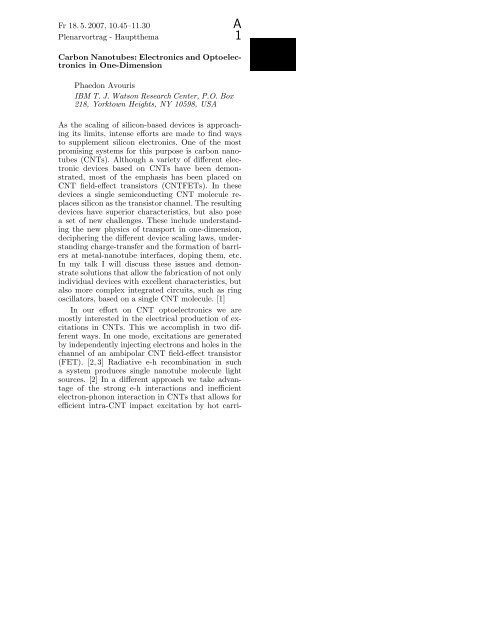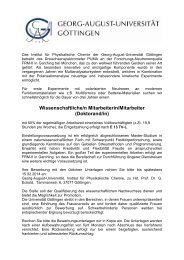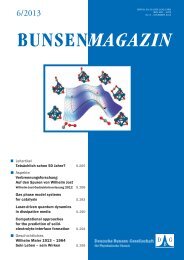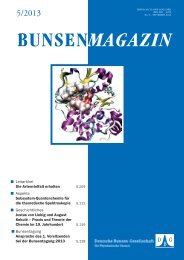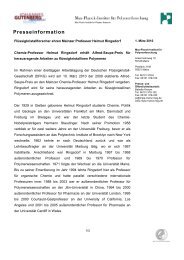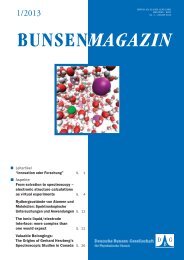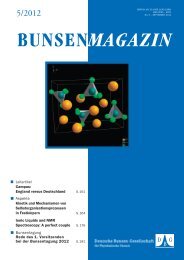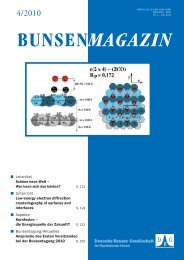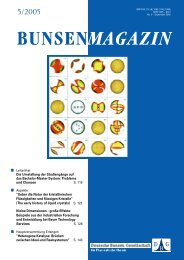- Page 1 and 2: Bunsentagung 2007 Graz 106. Hauptve
- Page 3 and 4: DEUTSCHE BUNSEN-GESELLSCHAFT FÜR P
- Page 5 and 6: Geschichte der Physikalischen Chemi
- Page 7 and 8: derte Vorlesungen an der Karl-Franz
- Page 9 and 10: tionalsozialismus wohlwollend gegen
- Page 11 and 12: festkörperchemische Untersuchungen
- Page 13 and 14: in Graz eine große Ausstrahlung au
- Page 15 and 16: Anreise Per Flugzeug nach Graz: Der
- Page 17 and 18: Mit dem PKW: Generell: Auf österre
- Page 19 and 20: Tagungsbüro Das Tagungsbüro befin
- Page 21 and 22: 16.30- 17.10 17.50- 18.30 14.00- 18
- Page 24: Vorträge — Sitzung A Vorträge
- Page 29 and 30: A Fr 18. 5. 2007, 14.00-14.40 3 Hau
- Page 31 and 32: A Fr 18. 5. 2007, 15.20-15.40 5 Kur
- Page 33 and 34: A Fr 18. 5. 2007, 15.40-16.00 6 Kur
- Page 35 and 36: A Fr 18. 5. 2007, 16.30-17.10 7 Hau
- Page 37 and 38: A Fr 18. 5. 2007, 17.30-17.50 9 Kur
- Page 39 and 40: A Sa 19. 5. 2007, 9.00-9.20 11 Kurz
- Page 41 and 42: A Sa 19. 5. 2007, 9.40-10.00 13 Kur
- Page 43 and 44: ment shows that CO therefore only d
- Page 45 and 46: A Sa 19. 5. 2007, 10.40-11.00 16 Ku
- Page 47 and 48: A Sa 19. 5. 2007, 12.10-12.30 18 Ku
- Page 49 and 50: A Fr 18. 5. 2007, 14.15-14.55 20 Ha
- Page 51 and 52: A Sa 19. 5. 2007, 14.55-15.15 21 Ku
- Page 53 and 54: A Fr 18. 5. 2007, 15.35-16.15 23 Ha
- Page 56 and 57: Fr 18. 5. 2007, 14.00-14.20 B Kurzv
- Page 58 and 59: Fr 18. 5. 2007, 14.20-14.40 B Kurzv
- Page 60 and 61: Fr 18. 5. 2007, 14.40-15.00 B Kurzv
- Page 62 and 63: Since nanoparticles of H 2 O, MeOH
- Page 64 and 65: Fr 18. 5. 2007, 15.40-16.00 B Kurzv
- Page 66 and 67: fekte festgestellt. Einer dieser Ef
- Page 68 and 69: Fr 18. 5. 2007, 17.10-17.30 B Kurzv
- Page 70 and 71: Fr 18. 5. 2007, 17.30-17.50 B Kurzv
- Page 72 and 73: Fr 18. 5. 2007, 17.50-18.10 B Kurzv
- Page 74 and 75: Fr 18. 5. 2007, 18.10-18.30 B Kurzv
- Page 76 and 77:
Sa 19. 5. 2007, 9.20-9.40 B Kurzvor
- Page 78 and 79:
Sa 19. 5. 2007, 9.40-10.00 B Kurzvo
- Page 80 and 81:
Sa 19. 5. 2007, 10.20-10.40 B Kurzv
- Page 82 and 83:
Zusammenfassend konnte durch die Ko
- Page 84 and 85:
proportion of the lipidated protein
- Page 86 and 87:
face area increase and no amide-I b
- Page 88 and 89:
tron donor cytochrome c [3]. As an
- Page 90 and 91:
Im Apoprotein wird bei Belichtung e
- Page 92 and 93:
Sa 19. 5. 2007, 14.35-14.55 B Kurzv
- Page 94 and 95:
Sa 19. 5. 2007, 14.55-15.15 B Kurzv
- Page 96 and 97:
Sa 19. 5. 2007, 15.15-15.35 B Kurzv
- Page 98 and 99:
Sa 19. 5. 2007, 15.35-15.55 B Kurzv
- Page 100 and 101:
Sa 19. 5. 2007, 15.55-16.15 B Kurzv
- Page 102 and 103:
Fr 18. 5. 2007, 14.00-14.20 C Kurzv
- Page 104 and 105:
ing from solvent-mediated particle
- Page 106 and 107:
exhibiting in water a pKa of about
- Page 108 and 109:
Fr 18. 5. 2007, 15.20-15.40 C Kurzv
- Page 110 and 111:
molecule. Furthermore, a dipole lay
- Page 112 and 113:
Au atoms on the MgO(001) surface. W
- Page 114 and 115:
porphyrin-coordinated metal ion and
- Page 116 and 117:
Fr 18. 5. 2007, 17.30-17.50 C Kurzv
- Page 118 and 119:
Fr 18. 5. 2007, 17.50-18.10 C Kurzv
- Page 120 and 121:
Fr 18. 5. 2007, 18.10-18.30 C Kurzv
- Page 122 and 123:
Sa 19. 5. 2007, 9.00-9.20 C Kurzvor
- Page 124 and 125:
Sa 19. 5. 2007, 9.40-10.00 C Kurzvo
- Page 126 and 127:
Sa 19. 5. 2007, 10.00-10.20 C Kurzv
- Page 128 and 129:
Sa 19. 5. 2007, 10.20-10.40 C Kurzv
- Page 130 and 131:
Dielektrizitätszahl belegt, deren
- Page 132 and 133:
Sa 19. 5. 2007, 11.50-12.10 C Kurzv
- Page 134 and 135:
in the c-direction. This clearly in
- Page 136 and 137:
spectroscopic data will be discusse
- Page 138 and 139:
auf. Die elektrischen Eigenschaften
- Page 140 and 141:
increase in the damping of the quar
- Page 142 and 143:
[2] Y.-G. Guo, Y.-S. Hu, and J. Mai
- Page 144 and 145:
elektrochemischen in-situ Methoden
- Page 146 and 147:
Die Bildung von Blasen während ano
- Page 148 and 149:
Fr 18. 5. 2007, 14.00-14.20 D Kurzv
- Page 150 and 151:
Fr 18. 5. 2007, 14.40-15.00 D Kurzv
- Page 152 and 153:
Fr 18. 5. 2007, 15.20-15.40 D Kurzv
- Page 154 and 155:
Fr 18. 5. 2007, 15.40-16.00 D Kurzv
- Page 156 and 157:
Fr 18. 5. 2007, 16.30-16.50 D Kurzv
- Page 158 and 159:
Fr 18. 5. 2007, 17.10-17.30 D Kurzv
- Page 160 and 161:
Fr 18. 5. 2007, 17.30-17.50 D Kurzv
- Page 162 and 163:
Sa 19. 5. 2007, 9.20-9.40 D Kurzvor
- Page 164 and 165:
Sa 19. 5. 2007, 9.40-10.00 D Kurzvo
- Page 166 and 167:
Sa 19. 5. 2007, 10.20-10.40 D Kurzv
- Page 168 and 169:
Sa 19. 5. 2007, 10.40-11.00 D Kurzv
- Page 170 and 171:
der Kraftkonstante im Minimum des e
- Page 172 and 173:
Sa 19. 5. 2007, 12.10-12.30 D Kurzv
- Page 174 and 175:
Sa 19. 5. 2007, 12.30-12.50 D Kurzv
- Page 176 and 177:
Sa 19. 5. 2007, 14.35-14.55 D Kurzv
- Page 178 and 179:
quency range from 1 mHz to 6 GHz. S
- Page 180 and 181:
Sa 19. 5. 2007, 15.35-15.55 D Kurzv
- Page 182 and 183:
Fr 18. 5. 2007, 14.00-14.20 E Kurzv
- Page 184 and 185:
Fr 18. 5. 2007, 14.40-15.00 E Kurzv
- Page 186 and 187:
Fr 18. 5. 2007, 15.20-15.40 E Kurzv
- Page 188 and 189:
erhöhte Reaktionsrate in denjenige
- Page 190 and 191:
Schaltzeiten möglich wird. Hierzu
- Page 192 and 193:
Fr 18. 5. 2007, 17.10-17.30 E Kurzv
- Page 194:
technique, a sharp tip is scanned o
- Page 197 and 198:
[1] T.W. Kim, R. Ryoo, K.P. Giersza
- Page 199 and 200:
P Fr 18. 5. 2007, 18.30-22.00 3 Pos
- Page 201 and 202:
P Fr 18. 5. 2007, 18.30-22.00 4 Pos
- Page 203 and 204:
P Fr 18. 5. 2007, 18.30-22.00 6 Pos
- Page 205 and 206:
P Fr 18. 5. 2007, 18.30-22.00 8 Pos
- Page 207 and 208:
P Fr 18. 5. 2007, 18.30-22.00 9 Pos
- Page 209 and 210:
applications. Controlled modificati
- Page 211 and 212:
(< 200 m 2 /g). In order to overcom
- Page 213 and 214:
P Fr 18. 5. 2007, 18.30-22.00 13 Po
- Page 215 and 216:
[1] A. Bornschlegl and U. Boesl, Ch
- Page 217 and 218:
P Fr 18. 5. 2007, 18.30-22.00 16 Po
- Page 219 and 220:
flexible bridges in various solvent
- Page 221 and 222:
P Fr 18. 5. 2007, 18.30-22.00 19 Po
- Page 223 and 224:
P Fr 18. 5. 2007, 18.30-22.00 21 Po
- Page 225 and 226:
P Fr 18. 5. 2007, 18.30-22.00 22 Po
- Page 227 and 228:
P Fr 18. 5. 2007, 18.30-22.00 24 Po
- Page 229 and 230:
verlustes von Temperatur und Sauers
- Page 231 and 232:
complete trajectory of the oscillat
- Page 233 and 234:
P Fr 18. 5. 2007, 18.30-22.00 28 Po
- Page 235 and 236:
P Fr 18. 5. 2007, 18.30-22.00 29 Po
- Page 237 and 238:
P Fr 18. 5. 2007, 18.30-22.00 30 Po
- Page 239 and 240:
P Fr 18. 5. 2007, 18.30-22.00 32 Po
- Page 241 and 242:
P Fr 18. 5. 2007, 18.30-22.00 33 Po
- Page 243 and 244:
P Fr 18. 5. 2007, 18.30-22.00 34 Po
- Page 245 and 246:
P Fr 18. 5. 2007, 18.30-22.00 36 Po
- Page 247 and 248:
P Fr 18. 5. 2007, 18.30-22.00 37 Po
- Page 249 and 250:
P Fr 18. 5. 2007, 18.30-22.00 39 Po
- Page 251 and 252:
P Fr 18. 5. 2007, 18.30-22.00 40 Po
- Page 253 and 254:
P Fr 18. 5. 2007, 18.30-22.00 41 Po
- Page 255 and 256:
P Fr 18. 5. 2007, 18.30-22.00 42 Po
- Page 257 and 258:
P Fr 18. 5. 2007, 18.30-22.00 44 Po
- Page 259 and 260:
P Fr 18. 5. 2007, 18.30-22.00 45 Po
- Page 261 and 262:
P Fr 18. 5. 2007, 18.30-22.00 46 Po
- Page 263 and 264:
P Fr 18. 5. 2007, 18.30-22.00 47 Po
- Page 265 and 266:
P Fr 18. 5. 2007, 18.30-22.00 48 Po
- Page 267 and 268:
P Fr 18. 5. 2007, 18.30-22.00 50 Po
- Page 269 and 270:
P Fr 18. 5. 2007, 18.30-22.00 52 Po
- Page 271 and 272:
P Fr 18. 5. 2007, 18.30-22.00 53 Po
- Page 273 and 274:
tems for the study the behaviour of
- Page 275 and 276:
geben daher Aufschluss über die so
- Page 277 and 278:
P Fr 18. 5. 2007, 18.30-22.00 57 Po
- Page 279 and 280:
chemically active Fe 3 O 4 support.
- Page 281 and 282:
P Fr 18. 5. 2007, 18.30-22.00 60 Po
- Page 283 and 284:
while the opposite deposition order
- Page 285 and 286:
P Fr 18. 5. 2007, 18.30-22.00 63 Po
- Page 287 and 288:
P Fr 18. 5. 2007, 18.30-22.00 64 Po
- Page 289 and 290:
stimmen. Vergleiche mit dem Radius
- Page 291 and 292:
P Fr 18. 5. 2007, 18.30-22.00 67 Po
- Page 293 and 294:
P Fr 18. 5. 2007, 18.30-22.00 68 Po
- Page 295 and 296:
P Fr 18. 5. 2007, 18.30-22.00 69 Po
- Page 297 and 298:
coordinated surface elements that a
- Page 299 and 300:
P Fr 18. 5. 2007, 18.30-22.00 72 Po
- Page 301 and 302:
Particular attention is paid to how
- Page 303 and 304:
P Fr 18. 5. 2007, 18.30-22.00 75 Po
- Page 305 and 306:
P Fr 18. 5. 2007, 18.30-22.00 76 Po
- Page 307 and 308:
P Fr 18. 5. 2007, 18.30-22.00 78 Po
- Page 309 and 310:
P Fr 18. 5. 2007, 18.30-22.00 80 Po
- Page 311 and 312:
P Fr 18. 5. 2007, 18.30-22.00 82 Po
- Page 313 and 314:
ermöglicht die Vorhersage der beob
- Page 315 and 316:
P Fr 18. 5. 2007, 18.30-22.00 85 Po
- Page 317 and 318:
P Fr 18. 5. 2007, 18.30-22.00 87 Po
- Page 319 and 320:
P Fr 18. 5. 2007, 18.30-22.00 89 Po
- Page 321 and 322:
P Fr 18. 5. 2007, 18.30-22.00 90 Po
- Page 323 and 324:
P Fr 18. 5. 2007, 18.30-22.00 91 Po
- Page 325 and 326:
P Fr 18. 5. 2007, 18.30-22.00 93 Po
- Page 327 and 328:
P Fr 18. 5. 2007, 18.30-22.00 94 Po
- Page 329 and 330:
P Fr 18. 5. 2007, 18.30-22.00 95 Po
- Page 331 and 332:
P Fr 18. 5. 2007, 18.30-22.00 97 Po
- Page 333 and 334:
Here we report the influence of ads
- Page 335 and 336:
P Fr 18. 5. 2007, 18.30-22.00 100 P
- Page 337 and 338:
P Fr 18. 5. 2007, 18.30-22.00 101 P
- Page 339 and 340:
P Fr 18. 5. 2007, 18.30-22.00 103 P
- Page 341 and 342:
P Fr 18. 5. 2007, 18.30-22.00 105 P
- Page 343 and 344:
P Fr 18. 5. 2007, 18.30-22.00 106 P
- Page 345 and 346:
P Fr 18. 5. 2007, 18.30-22.00 107 P
- Page 347 and 348:
P Fr 18. 5. 2007, 18.30-22.00 108 P
- Page 349 and 350:
P Fr 18. 5. 2007, 18.30-22.00 110 P
- Page 351 and 352:
P Fr 18. 5. 2007, 18.30-22.00 111 P
- Page 353 and 354:
et al. in flüssigem Hexadecylamin
- Page 355 and 356:
P Fr 18. 5. 2007, 18.30-22.00 114 P
- Page 357 and 358:
P Fr 18. 5. 2007, 18.30-22.00 116 P
- Page 359 and 360:
P Fr 18. 5. 2007, 18.30-22.00 117 P
- Page 361 and 362:
P Fr 18. 5. 2007, 18.30-22.00 118a
- Page 363 and 364:
P Fr 18. 5. 2007, 18.30-22.00 120 P
- Page 365 and 366:
P Fr 18. 5. 2007, 18.30-22.00 122 P
- Page 367 and 368:
P Fr 18. 5. 2007, 18.30-22.00 123 P
- Page 369 and 370:
P Fr 18. 5. 2007, 18.30-22.00 125 P
- Page 371 and 372:
P Fr 18. 5. 2007, 18.30-22.00 127 P
- Page 373 and 374:
propanol, attaches relatively stron
- Page 375 and 376:
[2] Mäkelä, R.; Vuolle, M. Journa
- Page 377 and 378:
from methane (Appearance Potential
- Page 379 and 380:
P Fr 18. 5. 2007, 18.30-22.00 132 P
- Page 381 and 382:
P Fr 18. 5. 2007, 18.30-22.00 133 P
- Page 383 and 384:
P Fr 18. 5. 2007, 18.30-22.00 135 P
- Page 385 and 386:
P Fr 18. 5. 2007, 18.30-22.00 136 P
- Page 387 and 388:
P Fr 18. 5. 2007, 18.30-22.00 138 P
- Page 389 and 390:
P Fr 18. 5. 2007, 18.30-22.00 140 P
- Page 391 and 392:
P Fr 18. 5. 2007, 18.30-22.00 141 P
- Page 393 and 394:
P Fr 18. 5. 2007, 18.30-22.00 143 P
- Page 395 and 396:
P Fr 18. 5. 2007, 18.30-22.00 144 P
- Page 397 and 398:
P Fr 18. 5. 2007, 18.30-22.00 146 P
- Page 399 and 400:
P Fr 18. 5. 2007, 18.30-22.00 148 P
- Page 401 and 402:
P Fr 18. 5. 2007, 18.30-22.00 150 P
- Page 403 and 404:
P Fr 18. 5. 2007, 18.30-22.00 152 P
- Page 405 and 406:
P Fr 18. 5. 2007, 18.30-22.00 153 P
- Page 408 and 409:
Index Ackermann P112 Adeagbo P79 Ad
- Page 410 and 411:
Fischer J.-H. P58, P60 Flechtner C8
- Page 412 and 413:
Koeppe B2 Köhler A. P116 Köhler M
- Page 414 and 415:
Paschek P145 Patchkovskii A21 Patzk
- Page 416:
Tran P17 Trettenhahn C28 Trimmel P7


